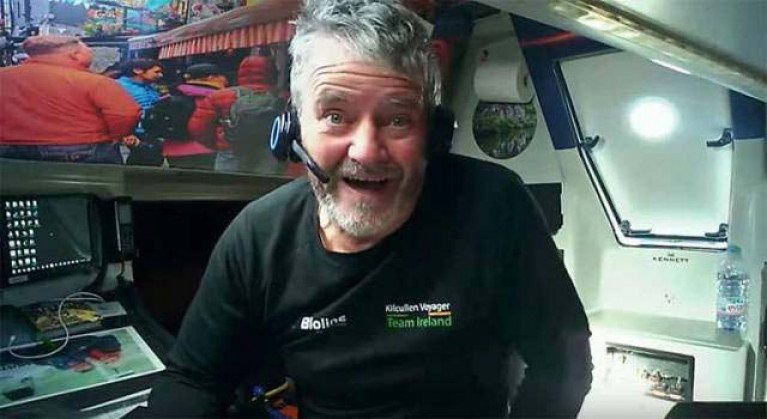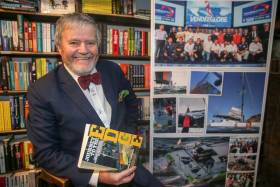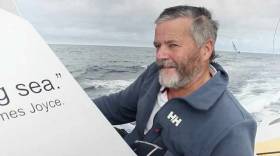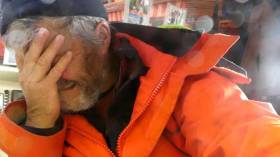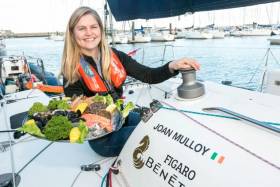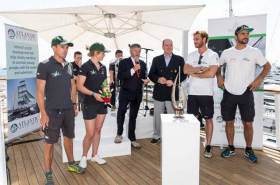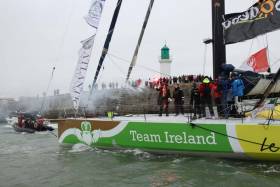Displaying items by tag: Enda O'Coineen
Enter the (Green) Dragon - O'Coineen Signs Up Volvo 70 for June's Round Ireland Race
Enter the Dragon. Enda O'Coineen, the Galway man behind the Irish entry in the 2008/9 Volvo Ocean Race is back behind the wheel of the Volvo 70 as the 12th entry into June's SSE Renewables Round Ireland Race.
It's not Green Dragon's first circuit of Ireland either, the Galway Bay yacht was the biggest and fastest of the 38-boat fleet in the 2012 edition of the race.
A year ago, under Johannes Schwarz’s Green Dragon crossed the finish line of the 7th edition of the RORC Transatlantic Race in an elapsed time of 9 days, 18 hours, 53 mins and 40 secs to win the IMA Trophy to take monohull Line Honours in the race.
 Enda O'Coineen - will co-skipper the Volvo 70 Green Dragon in June's Round Ireland Race from Wicklow Sailing Club
Enda O'Coineen - will co-skipper the Volvo 70 Green Dragon in June's Round Ireland Race from Wicklow Sailing Club
The Round Ireland campaign for Green Dragon will be is a joint entry from O’Coineen and Conor Ferguson. The boat is entered as both a Galway Bay Sailing Club and Royal Irish Yacht Club entry.
As regular Afloat readers will know, the original VOR team was captained by Ian Walker and finished the race in fifth place overall (from six starters) scoring 63 points. The boat was designed by Reichel Pugh and built by McConaghy Boats.
Ireland’s Hopes for a Tall Ship Are Running High
What goes around comes around. When Enda O’Coineen’s Atlantic Youth Trust revealed their interest in acquiring a classic three-masted topsail schooner from Sweden last Autumn for multiple maritime functions, of which sailing training would only be one, it set bells ringing in many ways — most of them positive.
The warmest feelings were aroused by the classic appearance of the 164ft Lady Ellen. For the reality is that these days, the professional seafarers who undertake the demanding task of being responsible for the safety, well-being and instruction of dozens of other people’s children in sail training programmes are themselves expecting certain standards of onboard comfort.
In fact, the more fastidious expect accommodation which equals that provided for their colleagues serving in the best ships of the international merchant marine and the leading navies.
As a consequence, many modern tall ships are a very odd combination of classic clipper ship forward, and a sort of mini cruise liner aft. In some of them, this effect is achieved to such gross effect that it reminds you of the old saying that a camel is a horse designed by committee.
 She looks like a proper classic sailing ship, and sails like one too
She looks like a proper classic sailing ship, and sails like one too
But when the first photos were released in Ireland of the Lady Ellen, everyone just gave a happy sigh. Her sweet appearance may be slightly marred by a sort of wheelhouse shelter right on the aftermost pin of the quarterdeck, but otherwise her deck cabins are of modest height, with the overall effect being one of harmony.
And for those with memories stretching back over many years, the appearance of the Lady Ellen was like a friendly ghost brought to life, as she is a reminder of the hopes of two great sea-minded people who pioneered the idea of an Irish tall ship at a time when officialdom seemed determined to obliterate any consciousness of our maritime potential.
 The inspirational Arklow-based Lady of Avenel
The inspirational Arklow-based Lady of Avenel
One was Jack Tyrrell of Arklow, whose schoolboy summers as ship’s boy aboard his uncle’s trading brigantine Lady of Avenel were so central to the beneficial shaping of his character that his lifelong dream was to provide subsequent generations with the chance to share a similar experience.
The other was an inspirational teacher, Captain Tom Walsh, who ran the little Nautical College in Dun Laoghaire, and kept the flame of Irish maritime hopes alive in what was a very thin time for Ireland and the sea. One result of this was that in 1954, Jack Tyrrell designed for Tom Walsh some proposal drawings for a 110ft three-masted barquentine to serve as an Irish sail training ship.
 We’ve been here before: the 1954-proposed 110ft barquentine, designed by Jack Tyrrell for Captain Tom Walsh, is remarkably similar to the Lady Ellen
We’ve been here before: the 1954-proposed 110ft barquentine, designed by Jack Tyrrell for Captain Tom Walsh, is remarkably similar to the Lady Ellen
 By the summer, this could be the Grace O’Malley
By the summer, this could be the Grace O’Malley
 Captain Tom Walsh of the Nautical College in Dun Laoghaire – seen here in 1957 – was ahead of his time in sail-training ship proposals
Captain Tom Walsh of the Nautical College in Dun Laoghaire – seen here in 1957 – was ahead of his time in sail-training ship proposals
In the slow-moving 1950s, it was an idea before its time. And when Ireland did finally get a national sail-trailing ship in 1969, it was through a completely different route, with the repurposed Asgard, Erskine and Molly Childers’ 1905-built Colin Archer 51ft ketch used in the 1914 Irish Volunteers gun-running to Howth.
She was and is a fine little ship, now conserved by the National Museum and on display in Collins Barracks. But she was too small for the job, and very soon a movement was under way to have her replaced with a larger “mini tall ship”. In the February 1973 issue of Afloat Magazine, proposal drawings by Jack Tyrrell appeared of a ship inspired again by the Lady of Avenel, but of a more modest size at 83ft hull length.
By this time the sail training programme was in the remit of the Department of Defence, as it tended to be shunted around whichever government minister was interested in the sea — the choice was never extensive. But the newly-appointed Minister for Defence, Patrick Sarsfield Donegan TD of Co Louth, was keen on boats and sailing. He willingly undertook the Asgard programme. And he happened to see those plans one morning as he was starting to make a very thorough job of celebrating his saint’s day in his own pub, the Monasterboice Inn.
 Jack Tyrrell of Arklow with Clayton Love Jr, Admiral of the Royal Cork YC and one of the founders — and the longest-serving member — of Coiste an Asgard
Jack Tyrrell of Arklow with Clayton Love Jr, Admiral of the Royal Cork YC and one of the founders — and the longest-serving member — of Coiste an Asgard
Thus there is absolutely no doubt that the decision to build the 84ft Tyrrell-designed and Arklow-built Asgard II was taken by Paddy Donegan on 17 March 1973, but it was March 1981 by the time she was in commission.
She gave excellent service, punching way above her weight on the national and international scene for 29 seasons, until in September 2008 she struck a semi-submerged object in the Bay of Biscay, and gradually but inexorably sank, with all the crew being safely taken off.
With Ireland going into economic freefall in the total crash of the Celtic Tiger, the then Government — to outside observers, at least — appeared to take advantage of the situation to divest themselves of the entire notion of a national sail-training ship and a government-administered programme to support it. This was so abundantly evident that dedicated maritime enthusiasts came to the conclusion that the only way forward was through a non-governmental trust functioning on an all-Ireland basis, and thus the Atlantic Youth Trust came into being under the inspiration of oceanic adventurer and international entrepreneur Enda O’Coineen.
There are hundreds of subtly different meanings to the word “no”, but Enda doesn’t understand any of them. He is totally resilient in face of setbacks, be they in business or when he’s alone out on the Great Southern Ocean. And he is of the opinion that general derision or a flat refusal is actually — if the other party only knew it — a cheery greeting and a positive reception of whatever way-out idea he is proposing.
 Galway rules the waves: Enda O’Coineen with President Michael D Higgins
Galway rules the waves: Enda O’Coineen with President Michael D Higgins
Nevertheless, the Atlantic Youth Trust’s concept — developed by its director Neil O’Hagan to provide a ship partially based on the Sprit of New Zealand’s realised vision of a floating classroom and expedition centre as much as a sail training ship — was well received but difficult to grow in a time of national austerity, with political turmoil in the all-Ireland context.
But the idea had certainly never gone away, and while there are many reasons as to why it is now tops of the agenda once more. The fact that the Lady Ellen was for sale last September in western Sweden played a key role, with the excitement of the chase being heightened by the fact that it had been thought she’d been sold elsewhere.
 Stripped down for winter, the Lady Ellen in Sweden awaits her new future in Ireland
Stripped down for winter, the Lady Ellen in Sweden awaits her new future in Ireland
However, that seemingly fell through, she came back on the market, and now the deposit has been paid by Atlantic Youth Trust supporters subject to all the usual legalities and technicalities, such that if everything proves acceptable survey-wise and under other headings, the deal has to be closed by the end of February.
While she was built as long ago as 1980 for a Swedish industrialist with personal attachments to the prototype, the 1911-built wooden trading schooner Lady Ellen, the current ship’s hull is in top-grade steel as used for submarine construction, so not surprisingly she came through a 2015 survey and major refit with flying colours.
 This is one serious ship, built in submarine-quality steel to last for a very long time
This is one serious ship, built in submarine-quality steel to last for a very long time
Yet to the casual observer she seems to be all wood in her finish, and therein lies an extraordinary problem that will have to be faced by the AYT when, if all goes according to plan, the ship undergoes significant work with the Harland & Wolff shipyard in Belfast in the spring.
For her present accommodation is positively luxurious by sail training standards, though her seagoing credentials are impeccable with 17 transatlantic passages logged. Yet below decks, we’re talking of en suite cabins for around 35 in all, whereas the trust will be seeking to up the accommodation to at least 40 and probably 45 in all, with 30-35 trainees plus five experienced youth leaders and five professional crew.
 The existing accommodation details may need significant amounts of unravelling in order to accommodate a total ship’s company of 45-plus
The existing accommodation details may need significant amounts of unravelling in order to accommodate a total ship’s company of 45-plus
 The saloon — taking up the full width of the vessel — makes such extensive use of wood and varnish finish that you forget you’re on a steel ship
The saloon — taking up the full width of the vessel — makes such extensive use of wood and varnish finish that you forget you’re on a steel ship
 Even the “basic” crew cabin reflects the “problematically high” quality of the interior finish
Even the “basic” crew cabin reflects the “problematically high” quality of the interior finish
When Jack Tyrrell was sketching out the accommodation for the Tom Walsh ship of 1954, he simply indicated space where the crew’s sleeping accommodation would be found. He may well have expected that the young people would be happily slinging a hammock from the deck beams.
But as the photos of the current ship indicate, while not totally luxurious, her accommodation is stylish, very well finished, glowing with the best of varnish-work, and generous with space. So some of it will have to come out, and we can only hope that it’s treated a little more kindly than the bits and pieces of the original Colin Archer interior for Asgard which, in 1968 when she was being converted for sail training by Malahide Shipyard, were brutally consigned to a bonfire.
 The separate cabins emphasise the high quality of the finish
The separate cabins emphasise the high quality of the finish
With repurposing all the rage these days, some of the ship’s current accommodation could certainly find some interesting and useful functions ashore, or in other boats. But the fact is while the vessel is being bought reportedly for the attractive price of €1.78 million, unbuilding and rebuilding can be an expensive process, as can the necessary replacing of standing and running rigging, and perhaps some spars.
Thus, if all goes according to plan with the deal closed at the end of February, the current project of getting the ship in commission in her new form, with the necessary shoreside support systems up and running, will be very rapidly making significant dents in the overall budget of €3 million.
And we have to remember that while the gallant Asgard II succeeded in punching above her weight among much larger tall ships, this new vessel is twice as long overall, making her in volumetric terms very much more than simply twice as large. So it’s going to take a considerable and constant effort to keep her in optimal trim and at full functional level. For apart from anything else, a busy ship is a happy ship, but a 164ft three-masted topsail schooner is a lot of ship to keep busy.
Yet the very fact that the Grace O’Malley, as she’ll be popularly renamed, has now come centre stage is just the tonic that we all need at this time of tiny slivers of hope, when it’s just possible the light at the end of the tunnel is not entirely a total pandemic express train coming the other way. We wish her well.
 She’ll be even more welcome than the flowers in spring – the Grace O’Malley may be coming to a port near you
She’ll be even more welcome than the flowers in spring – the Grace O’Malley may be coming to a port near you
The Royal Irish Yacht Club in Dun Laoghaire Harbour is launching its Virtual Regatta for members this Saturday with an online presentation by RIYC's round the world sailor Enda O’Coineen.
O'Coineen, whose Vendee Globe race bid to be the first Irishman to sail the world non-stop singlehanded ended when he was dismasted off New Zealand three years ago, will demonstrate how fellow RIYC sailors can compete for the inshore eSailing championships.
The tutorial starts online 14:30 hours followed by racing 15:30hrs
It's the latest in a series of online initiatives by the RIYC using software called ZOOM, each talk is presented by a RIYC Member or invited speaker.
No Alibis on Botantic Avenue in Belfast was the venue for the launch of Enda O’Coineen’s latest book, Journey to the Edge writes Betty Armstrong.
This cosy venue owned by David Torrans was filled with friends and the several large panels depicting aspects of the book were an eye-catching feature among the hundreds of other books in the store.
Enda told of his inspiration and motivation to undertake the challenging Vendee Globe, and the book is a captivating account of life before and after the event. (I had 30 pages read on the train home!)
The book is dedicated to the Atlantic Youth Trust Charity, founded by Enda with a mission to connect young people with the ocean, adventure and environment.
Journey to the Edge: An Amazing Story of Risk-Taking in Business and Adventure, by Enda O’Coineen, is available from the Afloat shop at €14.99.
Vendee Globe Sailor Enda O'Coineen To Feature on RTE Nationwide
On RTE's Nationwide programme this Monday evening at 19:00, Donal Byrne meets Enda O'Coineen to talk about his attempt to sail solo around the world and how it almost ended in disaster.
The programme features some dramatic and poignant footage from that Vendee Globe voyage and tracks O'Coineen's progress from the starting line in France to the South Island in New Zealand, near which he lost his mast in a mini hurricane.
O'Coineen also talks of what drove him to complete the voyage and how he managed to acquire another boat to do so. And Joan Mulloy also speaks of her ambition to raise enough sponsorship to follow in O'Coineen's wake to become the first woman to sail solo around the world.
Enda O'Coineen's book Journey to the Edge is available here
The World Premiere of the Irish sailing documentary 'Journey to the Edge' will be screened as part of the IFI Documentary Festival on Sunday, September 29th at 13.00 in Temple Bar, Dublin. The docu covers Irish sailor Enda O'Coineen's bid to compete in the Vendee Globe single-handed non-stop race around the world.
Every four years, an elite group of sailors endeavour to sail single-handed, non-stop in a circumnavigation of the planet, through the most unpredictable and perilous conditions imaginable. They are the competitors in the Vendee Globe Race – one of the most arduous, challenging and dangerous events in sport. These sailors know the real adversaries are the waves and the weather, the ice and isolation.
The 2016 race had an Irish skipper competing for the first time, as Galway businessman Enda O’Coineen sailed the Kilcullen Voyager into the history books. But this grand solo voyage did not go according to plan as Afloat documented at the time here.
This screening will be followed by a Q&A with director Peter Kelly and O’Coineen.
Screening as part of the 2019 IFI Documentary Festival, 25th – 29th September. Full details are here.
#Cruising - Vendée Globe challenger Enda O’Coineen will be part of the Royal Galway Yacht Club’s inaugural cruise in company from Galway Docks to the new marina in Rossaveal this Sunday 8 July.
BIM seafood ambassador and Figaro contender Joan Mulloy will lead the cruise on board her on board the 30ft racing boat Taste the Atlantic, departing from Galway Docks on the tide at 12pm and aiming to arrive in Rossaveal about four-and-a-half hours later
Other boats taking part are Evolution, a 60ft motorboat skippered by John Killeen, one of the club’s three commodores, and Kilcullen Team Ireland, the IMOCA 60 on which O’Coineen completed his solo global circumnavigation.
All boat owners in the area are invited to join the first of what’s hoped to be an annual event. O’Coineen promises some esteemed company — including Riverdance composer Bill Whelan, who hopes to sail down from Roundstone to meet the fleet.
The cruise is also a great opportunity to meet Joan Mulloy and show support for her Figaro campaign, as well as her own future Vendée Globe ambitions in 2020.
Prince Albert II of Monaco Honours Galway Sailor Enda O'Coineen, Joan Mulloy Sailing in New Globe Series
Solo sailor Enda O'Coineen was honoured by HSH Prince Albert II of Monaco at the weekend in recognition of the Galway man's successful circumnavigation.
Ireland had a strong presence in the principality on Saturday as the first Monaco Globe Series for the IMOCA 60 class got underway there.
O'Coineen is in Monaco to support his compatriot Joan Mulloy paired with Thomas Ruyant at the helm of Kilcullen Team Ireland.
Earlier that day, the Yacht Club de Monaco President greeted skippers at a brunch in honour of O’Coineen, who competed in the last Vendée Globe.
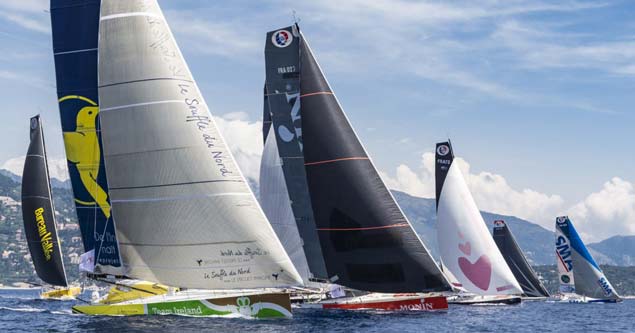 Joan Mulloy on board Team Kilcullen gets a great start in the new Monaco IMOCA series Photo: YCM
Joan Mulloy on board Team Kilcullen gets a great start in the new Monaco IMOCA series Photo: YCM
Nine 60-footers including County Mayo's Joan Mulloy are off on a double-hander, unassisted non-stop race, the first stage of the new IMOCA 2018-2020 world championship.
Organised by the Yacht Club de Monaco, the new race is a chance for participants to gain the maximum number of points towards qualifying for the Vendée Globe 2020.
The start gun was fired for the first Monaco Globe Series by Yacht Club de Monaco President, HSH Prince Albert II, from the elegant motor-yacht M/Y Pacha III (1936), on which were members of the royal family there to support Pierre Casiraghi competing with Boris Herrmann on Malizia II.
Prince Albert II of Monaco has strong connections to Ireland with Royal Cork Yacht Club. The Prince and RCYC's Gavin Deane signed a twinning agreement at YCM three years ago.
List of competing boats:
Malizia-Yacht Club de Monaco – Pierre Casiraghi / Boris Herrmann
SMA – Paul Meilhat / Gwénolé Gahinet
Newrest Art & Fenêtres – Fabrice Amedeo / Eric Peron
Bureau Vallée 2 – Louis Burton / Arthur Hubert
Monin – Isabelle Joschke / Alain Gautier
4myplanet2 – Alexia Barrier / Pierre Quirogea
Groupe Setin – Manuel Cousin / Alan Roura
Kilcullen Team Ireland – Joan Mulloy / Thomas Ruyant
Boulogne Billancourt – Stéphane Le Diraison / Stan Maslard
Click All Afloat.ie's Vendee Globe News
Enda O’Coineen “Unofficially” Finishes Vendee Globe & Completes Solo Circumnavigation
At 13:57 today off the west coast of France Irishman Enda O’Coineen passed through the finishing line of the Vendee Globe course to mark the end of his solo sailing lap of the planet, with just one stop.
On 6 November 2016 O’Coineen crossed the starting line of the solo non-stop race around the world From France to France. His world came crashing down around him on New Years Day 2017 when he broke his mast 180 miles south of New Zealand in one of the most remote parts of the planet.
Undeterred, the Irish team joined forces with a French entrant that was also forced to head to New Zealand for essential repairs. The new Team, Le Souffle du Nord Kilcullen Team Ireland emerged from a boat shed in Christchurch with a newly repaired and jointly branded yacht to complete the voyage.
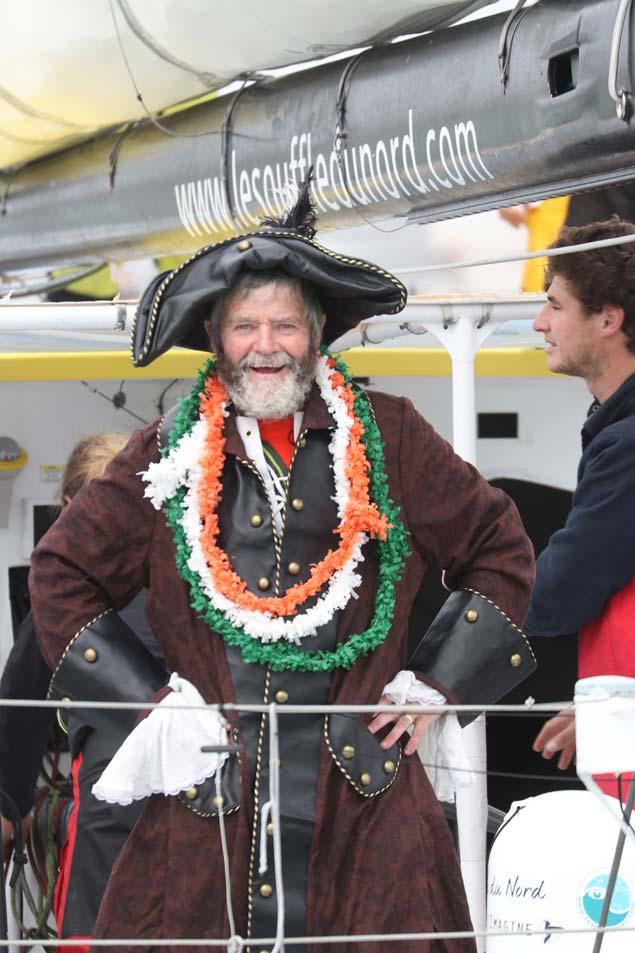 Enda O'Coineen in part mood after completing his solo circumnavigation
Enda O'Coineen in part mood after completing his solo circumnavigation
The second half of this epic adventure began on 26th January 2018 when O’Coineen sailed away alone from New Zealand with a destination some 13,000 miles away, through the Pacific Ocean, around Cape Horn, and back up the Atlantic and into Les Sables d’Olonne. This leg took 66 days alone at sea of nonstop sailing. The voyage saw him tackle ginormous seas off Cape Horn, becalmed waters along the coast of South America, and the last of the wild winter storms in the north Atlantic.
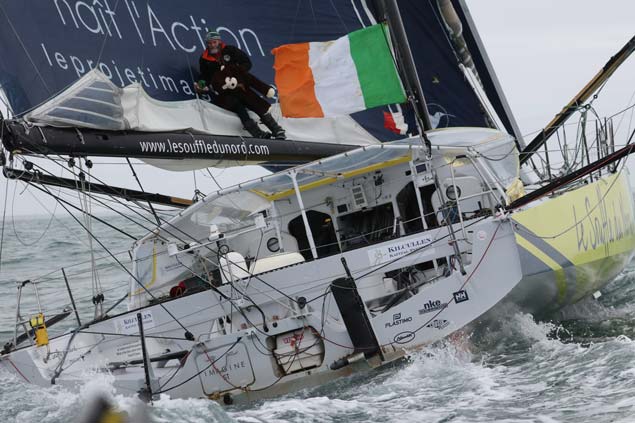 Enda O'Coineen sitting on the boom of his IMOCA 60 on arrival into the French port this afternoon
Enda O'Coineen sitting on the boom of his IMOCA 60 on arrival into the French port this afternoon
Speaking on arrival O’Coineen said:
"After 66 days alone at sea since New Zealand I am elated. It's incredible. I'm overwhelmed... and now I'm surrounded by thousands of people who gave me an amazing welcome into Les Sables d'Olonne. It's an honour to be here and to be representing Le Souffle du Nord Kilcullen Team Ireland. The support, interest and encouragement has been great.”
“This adventure really started in January 1st 2015 when we decided to 'Go for It' and to take on this challenge. Preparations have gobbled- up all the ranges of personal emotion, physical challenge, personal resource, fear and jubilation in between. There is no logic to the logic. And right to the finish line for the final week, rounding the Azores and the North West corner of Spain, the storm crossing the Bay of Biscay, kept me on edge."
By completing the solo lap of the planet Enda enters the history books of Irish sailing. Still to this day, 50 years since Sir Robin Knox-Johnston first sailed alone non-stop around the planet no Irish person has achieved this and only a handful have lapped the planet alone with just one stop.
O’Coineen finished by saying: “This really is an honour and I thank all who have followed the journey and supported us and our charity, the Atlantic Youth Trust.”
Read Afloat.ie's WMN Nixon: Enda O Coineen’s Latest Sailing Challenge Has Been an Inspiration For Us All
In his latest update from the Atlantic Ocean, Solo sailor Enda O'Coineen tells how he took a call from President Higgins as he crossed the Equator on his long voyage back home from New Zealand
The President of Ireland's Office called on the Sat. phone. As per SOB I answered " South Atlantic Residents Association. How may I direct your call"
Confused, the man almost hung up until I got him back and clarified my mistake. I should, of course, have said the " North Atlantic Residents Association… " - since we have just crossed the Equator.
The crossing was a truly magical moment, early Friday 16th March after 48 days at sea. King Neptune and his Court who gave us a personal audience and a warm welcome, having remembered us from the outward journey.
Then President Higgins came on the line and congratulated us on the voyage. This was indeed a great honour - not just for your humble skipper but all our partners, friends and those who have supported the project.
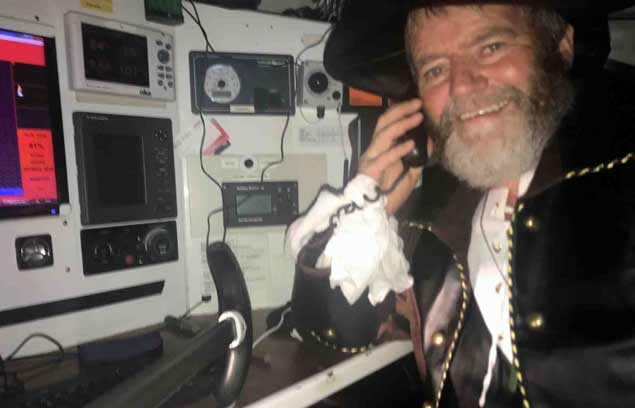
For those who have followed our ship's log through our Journey thanks for your interest. The Sunday Independent will be publishing the next Log so rather than my regular ' guff ' for those following the adventuure, I write about something special. Without shame ask to support. something incredible.
It can be small or large to help the Atlantic Youth Trust Charity We've had everything from £1 - £40,000 donated by individuals and companies so no amount is too small and it makes a difference.
To be clear, 100% of all funds will go to the Atlantic Youth Trust. And for the record the ATLANTIC Trust has not paid 1 cent towards the branding and promotion contributed through the Vendee. The Kilcullen Team Ireland Ocean project has in fact helped raise funds and profile both on the island of Ireland and internationally.
For me it is an honour to play a role in this initiative and thankfully, as business has gone well I have been able to support it financially myself. My late father, Lord rest him, always said " You should put something back in" here
I have been honoured to promote this charity. Will you actually do something? Now?
Atlantic's mission is clear to connect young people with the ocean and adventure.
As a child I was always in trouble at school and ' difficult" . I was fortunate to be selected to go on Asgard 1, a sail training vessel and it changed my life. Mind you many might say I am still difficult and in trouble - perhaps - one of another kind but this in not for me to judge.
Anyway Asgard II was lost, as was NI's vessel and the island of Ireland at the same time found itself rudderless in a tough recession. There was no appetite to rebuild.
It has been a tragedy for maritime youth development. We had no certified vessel or professional structure integrated to the education system to take youth to sea, introduce them to careers in the maritime and personal development.
As is often is the case with tragedy comes opportunity. Here the Atlantic Youth Trust saw is a once in a lifetime to look around the world with a 'clean-sheet" to see who did it best. Generous seed-funders came in and ATLANTIC in an independent project surveyed 16 countries and held Town Hall style meetings around Ireland to harvest views and build concensus for the best solution and value in a 30 year plus project,
This is a World Class, Youth Development Tallship. It will be professionally run but supported by a large Irish and Global volunteer based structure. Essentially the Maritime dimension to the Irish diaspora story - appropriate to think of on this St Patricks Weekend,
No matter who a child is, from any part of Ireland, they would have the opportunity to taste the ocean and adventure on this ship.
In our global research the New Zealand model stood out. With climate similarities in the South Island and similar populations. ATLANTIC their template, they are incredibly helpful and we have had several exchanges.
The economic model shows a massive return on investment for youth at risk, those following careers at sea, marine industry development, even tourism promotion and much more,
Incredible progress has been made. Teams in NI and ROI are working on details to move forward but the project urgently needs smart seed funding and public support to keep going. See www.Atlanticyouthtrust org.
Also some great member trustees have got in behind the organization and mission. Thee are led by the Chairman Peter Cook, David Beattie, Sean Lemass, John Killeen, John Coyle, Jerry Dowling, Sean Lemass, Gerard O'Hare to mention just a few It is a professionally run charity. Neil O'Hagan is the CEO and ite offices are kindly sponsored by Irish Lights, the North-South navigation authority.
You'll find ways to donate online here
ATLANTIC have gifts small and large for all donations over £30 and I am happy to consider any corporate speaking type activities in return for a donation to the Trust.
Now, in theory the circumnavigation is complete. The Equator marks the beginning of the End in what has been an extraordinary adventure and very tough challenge. Also TEAM Ireland Ocean want to keep going and would like people to get in behind Gregor McGuickan's entry in the Golden Globe Around the World Challenge and Joan Mulloy in the FIGARO this year and Nin O'Leary's Vendee plans with IOR.
However its not over. Now its north through the Doldrums, the North Easterly Trade Winds past the Caribbean and up the North Atlantic leaving the Azores High to starboard to finish in early April. Now that's an excuse for a great party.
But please pleaae make a contribution to the ATLANTIC Youth Trust. Every bit counts.




























